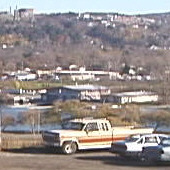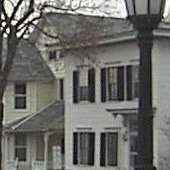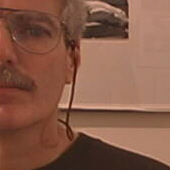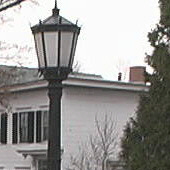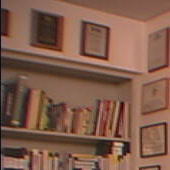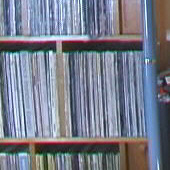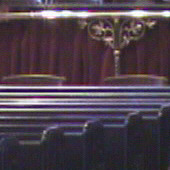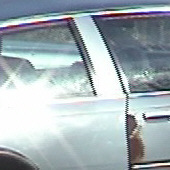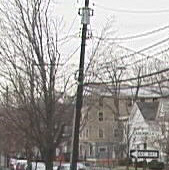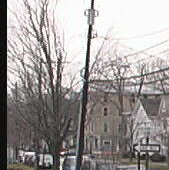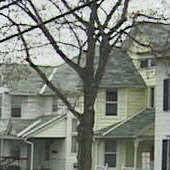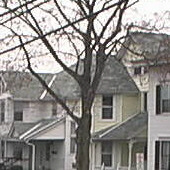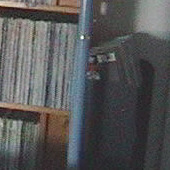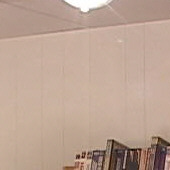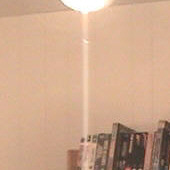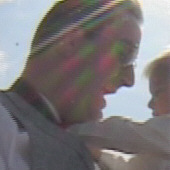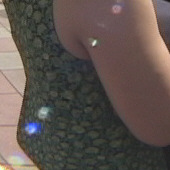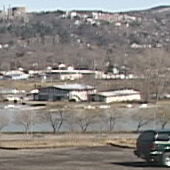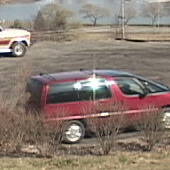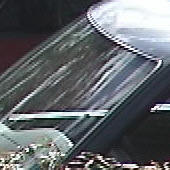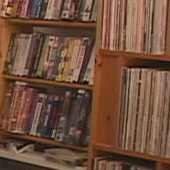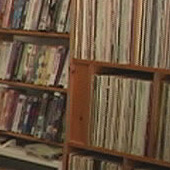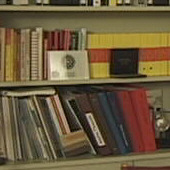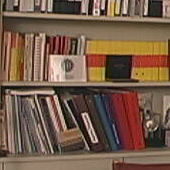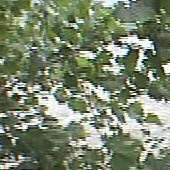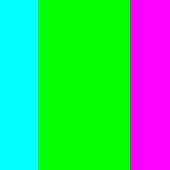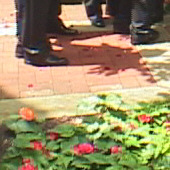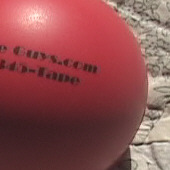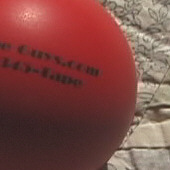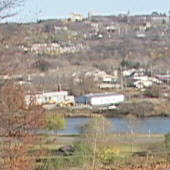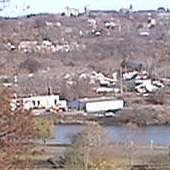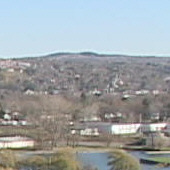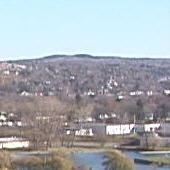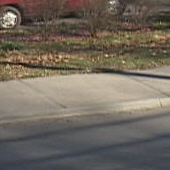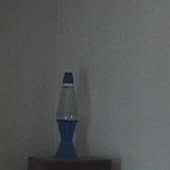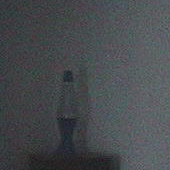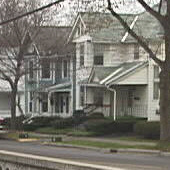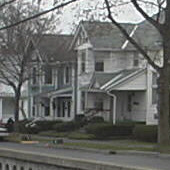On Video Image Characteristics and Faults
DAVID RUETHER
(First posted April 3, 2002 - last modified May 10, 2002)
In comparing various camcorders, or in judging the image quality of a particular video camcorder (or even of a particular video medium), it is useful to have some idea of what the various picture characteristics are, and what represents relatively "good" and "poor" performance, especially since few would say that images made in the commonly available standard-definition digital motion-video media of the examples shown here represent "high quality" compared with that
of related media such as 35mm motion-film, film-stills, or motion-HDTV. It is therefore desirable to optimize as much as possible the SD video image, given its great inherent limitations - and one obvious way to do this is by selecting video gear that has the best possible image quality. Below are good and poor examples for several picture image performance characteristics, taken from "D25" or "Mini-DV/DVCam", since this is currently the most popular video medium in use capable of providing acceptable (or better) levels of image quality.In my various exchanges on Usenet newsgroups with various brand and model camcorder adherents, it is evident that some people prefer the "look" of technically inferior images, just as in still photography or other media, the "look" of a particular non-standard way of producing images is favored by some and is used to produce a desired "effect". It is my conviction that it is best to use the most capable general-purpose characteristic-neutral gear that can reasonably be obtained so that the user is less limited in the range of what the gear can be appropriately used for. One can then apply (either in-camera or afterwards during editing) any effect one wants to use, for any "look" that is sought. Without neutral-characteristic tools, however, all output is "colored" by the gear limitations and biases; universality of applicability is therefore obviously a desirable and less-limiting attribute of gear. If one wants soft focus, for instance, it can be applied with filters on the lens or by softening the image while editing, rather than by using a sub-standard lens or camera which then prevents good sharpness when desired. This also applies to color biases, etc. (we can all shoot a great picture or two using a box Brownie, but I would hate to be limited in my photography by its imaging characteristics, much as I might like the particular "look" of its images). The best gear really is "best"...
Note:
Most of the sample images below are taken from various camcorder reviews and articles that appear elsewhere on this web site (see the video section of
"I Babble" for these), others are from footage shot for other purposes. The samples are generally 170x170 pixels cropped from 720x480 originals grabbed from motion-video, and are "actual size", not enlargements. Generally, the reference example is on the left (if any), and the fault example is on the right.
The camera used for each example is not revealed with the example so that the observations are less "colored" by the preconceptions and prejudices of the viewer (though some might enjoy playing "matching the pictures" with the frame-grabs in the review comparison articles - but I have added a "key" for those without the patience...;-). Where I do not have good examples to show for some of the characteristics, I refer you to other web articles that do. Either select an image characteristic from the list below, or just jump in and go through them all (best the first time, since it may take a while for the many image examples to load with a dial-up connection...).>> Focus and Depth of Field 0
>> Resolution and Detail-Rendition TRV900,PC9;V900,TRV9
>> Over-Sharpening XL-1,GL-1
>> Sharpness Corner/Edge Roll-Off XL-1+WA
>> Color Fringing - Chromatic Aberration XL-1+WA,TRV900
>> Spurious Color - One-CCD Color Filtering PC100+WA,PC9
>> Illumination Corner/Edge Roll-Off VX2000,VX2000
>> Vignetting VX2000+SonyWA
>> Image Width TRV900,GL-1
>> Exposure TRV11+Fisheye
>> Contrast VX1000,TRV900,GL-1;VX2000,PC9
>> Brilliance VX2000,PC9
>> CCD and Shutter Light-Spread VX2000,TRV30,VX2000
>> Flare VX2000+Fisheye
>> Ghosting VX2000+Fisheye
>> Diffraction VX2000,VX2000;VX2000,VX2000
>> Distortion VX2000+WA
>> Stair-Stepping PC1, PC100;VX2000,EZ30U;VX1000,GL-1;PC100
>> Moire Patterning TRV30
>> Mosquito Noise 0
>> Color Edge Effects (NTSC) 0
>> Dropout, Banding 0
>> Color Blooming VX2000,VX2000,TRV900
>> Color Bias/Neutrality 00,GL-1;EZ30U,XL-1
>> Color Purity/Saturation VX2000,PC100
>> Color Tinting VX2000,TRV900;VX2000,TRV30
>> Color Noise VX2000,PC100
>> Color Depth TRV900,XL-1
>> Progressive Scan Effects 0
KEY_____________________________________________________
_____________________________________________________|---- Sharpness and Illumination Effects ----|
(Due to the Lens, CCD, and Electronics)
>>>>>>>>> Focus and Depth of Field:Basic to the operation of almost all cameras is the ability to focus the image properly and consistently on the imaging surface. For manual focus, a good, reliable method for adjusting the lens focus and for holding that focus, and a good, sufficiently sharp viewfinder for judging focus quickly and easily are needed. For autofocus, a reliable system is required that attains correct focus quickly and decisively, without hunting, in all light levels of interest, with normal framing. Video cameras vary considerably in the degrees to which they satisfy these requirements. Focal lengths for most of these video cameras are sufficiently short that achieving universal depth of field is generally easy; achieving shallow DOF is more difficult.
>>>>>>>>> Resolution and Detail-Rendition:
In the sample pairs above, it is easy to see the differences in resolution by looking at the level of detail shown. In general, the camera system that can provide the highest resolution is preferable - though with some cameras, the higher resolution brings with it some problems (excessive "stairstepping", scan-line "flapping" effects, Moire patterning, mosquito noise, etc.). Also, it is easy to confuse excessive contrast and oversharpening with good resolution, but these faults generally mark a camera maker's attempt to make a lower-resolution image look sharper.
>>>>>>>>> Over-Sharpening Effects:
In an attempt to make a lower resolution image look sharper, an electronic "ringing" is introduced to exaggerate edge contrasts, separating tonal areas. This edge effect can look like a black-line or white-line outlining of image parts, giving a "cartoon drawing" effect. A white line can be seen along the shirt edge, and at the edges of the glass panels in the street light. Compare the street light above with the same in the two similar images in "Resolution", and notice that the left image of those shows higher resolution, but with less over-sharpening.
>>>>>>>>> Sharpness Corner/Edge Roll-Off:
Common at wide stops with inferior lenses (and with many lens and converter combinations) is a reduction in frame corner and edge image resolution compared with the center.
>>>>>>>>> Color Fringing (Chromatic Aberration):
Common at wide stops with inferior lenses (and with some lens and converter combinations) is the appearance of red/green color fringing in the frame edges and corners. The strong overall red color bias fault in the left example tends to overwhelm the green fringing, but you can see it on the upper and left edges of the picture frames in this example if you look carefully. You can see the red and green fringes on the shelf and record tops in the right side example.
>>>>>>>>> Spurious Color (One-CCD Color Filtering):
Common with one-CCD camcorders when shooting high-contrast fine-textured subjects is the appearance of yellow/purple color fringing due to the limitations of the filtering used to provide color in the image.
>>>>>>>>> Illumination Corner/Edge Roll-Off:
Common at wide stops with most lenses (and with some lens-converter combinations) is the smooth and gradual shading off of illumination toward the frame corners. The first example above was shot at f11, the second at f1.6 - and both are from the far upper-left sections of frames with the same overall central brightness.
Common with wide-angle lens attachments or lens shades that are too small (though sometimes it is seen less distinctly, caused by internal camera obstructions) is the fairly sharp cutoff of illumination near the corners (though it can also affect edges). If it is close enough to the corners (as in this example in the upper left), it will not be seen in the TV-safe area unless moved into that area by a filter, effect, or transition.
The image on the right shows a picture area (the black strip) that does not occupy the full frame width with camera-image. This is close enough to the edges that it will not be seen in the TV-safe area unless moved into that area by a filter, effect, or transition. This does limit what filters, effects, and transitions can be used with the images produced by this camera.
>>>>>>>>> Exposure (Brightness) Effects:
It is common for cameras in auto exposure modes to slightly overexpose either interiors or exteriors, or both. Slight overexposure tends to make the image seen on most TVs appear slightly less sharp and with colors that are somewhat lower in saturation - and with considerable overexposure, the picture looks "washed out" and too bright. Underexposure makes viewing difficult in bright environments. When correcting exposure errors during editing, it is easier to fully-correct underexposed images than to correct even moderately overexposed images. An AE-bias control on the camera is useful for controlling exposure while keeping the advantages of auto exposure, as is a good viewfinder that is adjustable in brightness, especially one with "zebra stripes" to indicate highlight record levels. With some camcorder models without exposure control, switching to "spotlight" program mode may slightly lower average exposures, producing richer and sharper-looking images.
In the top examples are three levels of contrast: normal, slightly high, and excessively high. High contrast is often used by the camera designer to produce a "crisper", sharper-looking image when the resolution is low, but the result is that highlights (like the sky detail, above) "burn out" easily, shadow detail is lost, good exposure is harder to achieve, and some negative picture characteristics are exaggerated. In some circumstances the higher contrast image can look good, but in general it limits what can be shot successfully with the camera. During editing, contrast can be increased easily, if desired, but it generally cannot be reduced as successfully. In the bottom examples the sample on the left shows the range of tones one can generally expect from a good 3-CCD camera; on the right the lighter tones have turned white, a characteristic of most 1-CCD cameras.
Related to, but not the same as, contrast is brilliance, the range between the darkest and lightest tones. While very unusual, it is possible to have low contrast and high brilliance in the image, and more usual to have high contrast and low brilliance, but most often, high contrast and brilliance go together, or low contrast and brilliance go together (as in the example on the right, with poor whites and blacks).
>>>>>>>>> CCD and Shutter Light-Spread:
In video, the tall vertical white line emerging from a light source was mostly associated with high shutter speeds, but now it is also characteristic of "HAD"-type CCDs on 1-CCD cameras even at slow shutter speeds. The bloom of the very strong highlight in the third example is also a "HAD"-associated effect (on a 3-CCD camera).
|--------- Other Lens Effects ---------|
Flare is common in most lenses if a strong enough light enters the lens relative to the brightness of the other image parts. It is a diffuse and brilliance-lowering effect caused by repeated bouncing and spreading of light inside the lens and camera. Flare is most often caused by an out-of-frame light source and can often be controlled by the use of a lens shade, though cameras and lenses do vary in their tendencies to show flare. (Ignore the diffraction ray from the sun in the image example above.)
Similar to flare in cause, it is generally a distinctive fairly sharp-edged series of reflections showing the diaphragm shape. It does not reduce picture brilliance, so it is therefore a more desirable fault than flare. While flare and ghosting can be reduced with careful design, almost all light-imaging devices are subject to them under commonly-occurring conditions. A lens shade may help prevent some ghosting, but it is often caused by a bright light within the image area.
>>>>>>>>> Diffraction Effects:
As lenses are stopped down by diminishing the diaphragm size from wide open, lens aberrations tend to be reduced in effect, but at some point the resolution limiting effect of diffraction becomes more important than the lens performance improvements derived from stopping down. This results in an optimum relative aperture for best resolution for a lens, and this f-stop varies with focal length, format, and lens design quality. This effect is quite noticeable in high-resolution media like still film photography, but less so in low resolution media like video. Even so, you can see a slight sharpness difference between the frame on the left (shot at f4), and the one on the right (shot at f11, the smallest stop on the camera). I have seen good results with stops as small as f32 used with video cameras, but this aperture would be unacceptable for small-format stills, all else being equal.
In these two examples you can see the effect of diffraction around the diaphragm blades with a very bright, near-point light (shot at f1.6 and f11). If you imagine every point in the subject being rendered as a point in the image (as it would be ideally, in a perfect-resolution system), you can imagine the effect of turning every subject point into a much larger star-shaped image point as a result of diffraction. While lower brightness will produce less spread in the points, some spread of the image points will occur from diffraction resulting from using very small relative apertures.
For more on diffraction in video, look here.
Common to most zoom lenses (and to a lesser extent, to most other lenses) is linear distortion. It comes in three main "flavors": barrel (as above, where the straight road is curved away from the image center), pincushion (where off-center images of straight lines in the subject are curved inward toward the image center), and wavy-line (a mix of the two types). Of these, barrel distortion is the most desirable (other than none, possibly - for more on this, and why barrel distortion can be useful, and may even be considered not "distortion" at all, look here). Strong barrel distortion occurs most often when using wide-angle lens converters (as in the example above), especially "fisheye" converters.
|-------- Compression and Scan-Line Effects --------|
>>>>>>>>> Stair-Stepping and Related Effects:
Common in video, since the image is formed with scan lines, is an effect seen with motion that resembles stair steps or a saw edge. With the best analogue video gear, this effect is minimal, is seen mostly on near-horizontal lines, and it goes away when motion stops. In DV, this spatial aliasing effect can be far
more pronounced.
Depending on the electronics and programming in various D25 models, this image fault may be minor, or it may persist without motion, affect near-vertical lines or even diagonals in addition to the usual near-horizontal lines, cause the appearance of straight line discontinuities, and show as severe "flapping" along scan lines. These are all rather unpleasant picture effects. In the right side examples in the image pairs above, you can see this effect as vertical line discontinuities in the upper one, and as spurious diagonal lines in the lower. While these image defects are common with the sharpest 1-CCD camcorders, both the examples above occurred in 3-CCD models.
In the example above, this "flapping" effect, seen most prominently in "megapixel" one-CCD cameras (but still slightly present in the best 3-CCD DV models), looks like abrupt vertical subject width changes with vertical motion. The result of all these effects is a very "busy-looking" video image with camera or subject motion. (For more on stair-stepping and related spatial aliasing effects, look at Adam Wilt's article on "quilting", here.)
As regular spurious patterning increases in the image, more interference occurs with scan lines on TVs when these "busy" images are viewed, forming distracting Moire patterns. This is another spatial aliasing effect.
As resolution increases, especially with subjects with fine detail, more problems arise with the 5:1 D25 compression, resulting in tiny "busy" areas in the picture. (For more on this, see Adam Wilt's article at: www.adamwilt.com/pix-artifacts.html.)
>>>>>>>>> Color Edge Effects (NTSC):
D25 NTSC is compressed 4:1:1; PAL is compressed 4:2:0. A result of this is that some color edges in NTSC are not sharp. The left image is from color bars jpg'd directly; the right image is the same, but imported into a video editor, rendered in DV-AVI NTSC using one of the best DV-AVI codecs, the Canopus, and exported as a frame. The differences are unfortunately obvious... (For more on this, see Adam Wilt's web page, at: www.adamwilt.com.)
While visible dropouts in DV are rare (the error-correction and hiding methods used are very effective), some dropout faults can show. (For examples and more on this, go to Adam Wilt's article, here.)
|------------ Color Effects ------------|
Red is a particularly difficult color to show properly in video, and in addition to common problems with color accuracy, red subjects may also appear to have very little detail and they may spill red color into other picture areas. Cameras vary in their ability to show red (and sometimes bright orange) subjects as well as subjects of other colors.
>>>>>>>>> Color Bias/Neutrality:
A very common problem in video is predominant color biases in cameras. In the upper pair of examples, the image on the right shows even the very light sky with the red bias of this camera. In the lower pair, the right image shows the strong orange bias of this camera. While people often like "warm"-colored images, it is a disadvantage for general shooting to have strong color biases built into the camera. If desired, color biases can be added with filters placed on cameras which have more neutral and accurate color, or they can be added during editing.
>>>>>>>>> Color Purity/Saturation:
Cameras vary in the saturation and purity of their color rendition. With the best, the color in the video looks very much like the color in the subject; with the worst, it is considerably altered. A very few cameras can show bright, clean, saturated color when this is present in the subject.
Different from color bias, in which a strong overall color shift has occurred, is tinting. In the upper pair of examples, the image on the right shows noticeable green and red content in the blue sky. If you look at the grey areas in the lower examples and think "red", "green", or "blue", you may see that the "grey" areas (more in the right example than the left) actually have all these colors within! Only a very few cameras at this level are relatively free of this color error.
Cameras vary in their ability to show color with low levels of color noise, particularly in low light levels where increased gain can exaggerate the appearance of "grain", but noticeable color noise can show even in bright light with some cameras.
A couple of cameras have limited color "bit-depth", resulting in the inability to show subtle colors very well. In the image on the left, the siding and roofing colors are believable and accurate; in the image on the right, there is very little color at all.
|------ Progressive Scan Effects ------|
Many cameras offer the "progressive scan" feature, which confuses users. It is intended for displaying alternating fields with proper timing to avoid the "comb-edge" look when still frames are grabbed from the video. In some cameras, using it reduces frame resolution somewhat and drops the "frame" rate from 60 fields a second to 30 frames per second (NTSC), producing less sharp motion-video with a "jerky" look with motion - but frames grabbed from the motion-video look better. In other cameras the progressive scan mode is intended only for stills and it is optimized for this use, providing higher stills quality - but the look of the motion-video shot in this mode is unacceptable. In general, unless there is a very specific reason for doing otherwise, the best-looking motion-video is shot in interlaced mode, which is the most compatible with most current standard-definition TVs.
______________
______________All of this is copyrighted material (David Ruether, 2002), and may not be reproduced without permission. Permission is granted to copy this material (including any of the still photos) for personal use only.
"Hope This Helps"
David Ruether (d_ruether@hotmail.com)
Video Index Articles Index David Ruether Photography Site Map
